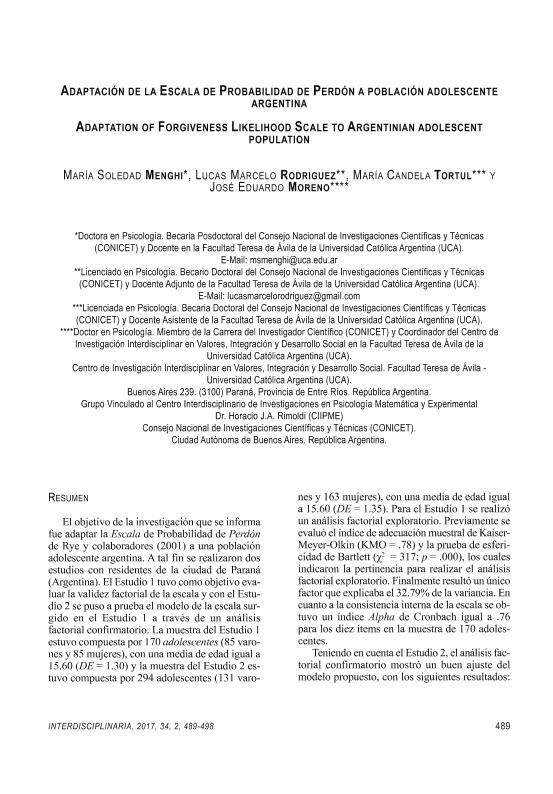Artículo
La presente investigación tuvo como objetivo adaptar la Escala de Probabilidad de Perdón de Rye y otros (2001) a población adolescente argentina. A tal fin se realizaron dos estudios. El Estudio 1 tuvo como objetivo evaluar la validez factorial de la escala. El Estudio 2tuvo como objetivo poner a prueba el modelo de la escala surgido en el Estudio 1 a través de un análisis factorial confirmatorio. La muestra del Estudio 1 estuvo compuesta por 170 adolescentes (85 varones y 85 mujeres), con una media de edad de 15.60 (DS= 1.30).La muestra del Estudio 2 estuvo compuesta por 294 adolescentes (131 varones y 163 mujeres),con una media de edad de 15.60 (DS= 1.35). Ambas muestras de la ciudad de Paraná, Argentina. Para el Estudio 1 se realizó un análisis factorial exploratorio. Previamente se evaluó el índice de adecuación muestral de Kaiser ? Meyer ? Olkin (KMO= .78) y la prueba de esfericidad de Bartlett (X2 = 317.00; p = .000), los cuales indicaron que era pertinente realizar el análisis factorial exploratorio. Finalmente resultó un único factor que explicaba el 32.79% de la variancia. En cuanto a la consistencia interna de la escala se obtuvo un índice alfa de Cronbach de .76 para los diez ítems en la muestra de 170 adolescentes.Teniendo en cuenta el Estudio 2 el análisis factorial confirmatorio mostró un buen ajuste del modelo propuesto, con los siguientes resultados: χ2(32)= 86.27 p=.000 χ2/gl=2.69 CFI= .93 GFI= .94 RMR= .059 y RMSEA= .076. La adaptación del instrumento mostró buenas propiedades psicométricas de la escala para el uso en población argentina. Forgiveness has positive implications for the emotional and social development. Several investigations have concluded that there is a strong negative correlation between forgiveness and the expression of anger and depression. It has been empirically shown that forgiveness has positive effects on mental health and psychophysical wellbeing. Through this capability the negative feelings of revenge and resentment are transformed into more positive feelings such as compassion and generosity, allowing to convert a negative and painful past into a positive one, thus strengthening the experiencesthrough a reflective and peaceful look. In adolescence grievance situations are usually very frequent. Faced with these situationsforgiveness is of great importance to restore the bonds between peers or family; essential bonds for the emotionalsupport at thisstage. This clearly shows the importance in the profound study of forgiveness as a variable that fosters psychological health in adolescence. This requires having instruments with good psychometric properties that can measure the ability to forgive in the Spanish -speaking population, more precisely the one from Argentina. The objective of this paper is to adapt Rye’s Forgiveness Likelihood Scale (2001) to theArgentinian adolescent population. Two studies were conducted for this purpose. The aim of Study 1 was to evaluate the factorial validity of the scale. Study 2 aimed at testing the scale model emerged in Study 1 through a confirmatory factor analysis. The Study 1 sample consisted of 170 adolescents (85 males and 85 females) with a mean age of 15.60 (SD = 1.30). The Study 2 sample consisted of 294 adolescents (131 males and 163 females) with a mean age of 15.60 (SD = 1.35). Both samples were from Paraná City (Argentina). In both studies the samples were obtained in the same way. It was contacted secondary schools authorities to give them information about our research and to get their permission to carry it out. Then, parents’ authorization was asked (informed consent). The samples were taken in groups of 20 to 30 adolescents approximately. During the administration at least two researchers were present. It was obtained the KMO sampling adequacy Index (.78) and the Bartlett Test of Sphericity (χ2 = 317; p = .000), both of them indicate that it is appropriate to conduct the AFE. From the factor analysisthe result isthe existence of a single factor that explains 32.79% of the variance. To assess the internal consistency of the Forgiveness Likelihood Scale, the Cronbach Alpha was calculated,showing a coefficient of .76 for the ten items of the scale in the sample of 170 adolescents. As for Study 2, the results of confirmatory factor analysis are: χ2 (32) = 86.27; p = .000, χ2 /gl = 2.69, CFI = .93, GFI = .94, RMR = .059, and RMSEA = .076. These results indicate a good fit of the proposed model. Thus, both studies convey the good adaptation and psychometric properties of the Forgiveness Likelihood Scale to Argentinian adolescent population. One of the limitations of the present research is the lack of convergent and discriminant validity studies. Both studies were conducted with the original version of the scale, obtaining a positive correlation with the Enright Forgiveness Inventory and other forgiveness measures. Further research should include this type of studies.
Adaptación de la Escala de Probabilidad de Perdón a Población Adolescente Argentina
Título:
Adaptation of forgiveness likelihood scale to argentinian adolescent population
Fecha de publicación:
12/2017
Editorial:
Centro Interamericano de Investigaciones Psicológicas y Ciencias Afines
Revista:
Interdisciplinaria
ISSN:
0325-8203
Idioma:
Español
Tipo de recurso:
Artículo publicado
Clasificación temática:
Resumen
Palabras clave:
Perdón
,
Adolescentes
,
Propiedades Psicométricas
,
Escala
,
Agravio
Archivos asociados
Licencia
Identificadores
Colecciones
Articulos(CIIPME)
Articulos de CENTRO INTER. DE INV. EN PSICOLOGIA MATEMATICA Y EXP. "DR. HORACIO J.A RIMOLDI"
Articulos de CENTRO INTER. DE INV. EN PSICOLOGIA MATEMATICA Y EXP. "DR. HORACIO J.A RIMOLDI"
Articulos(OCA SAAVEDRA 15)
Articulos de OFICINA DE COORDINACION ADMINISTRATIVA SAAVEDRA 15
Articulos de OFICINA DE COORDINACION ADMINISTRATIVA SAAVEDRA 15
Citación
Menghi, María Soledad; Rodriguez, Lucas Marcelo; Tortul, María Candel; Moreno, Jose Eduardo; Adaptación de la Escala de Probabilidad de Perdón a Población Adolescente Argentina; Centro Interamericano de Investigaciones Psicológicas y Ciencias Afines; Interdisciplinaria; 34; 2; 12-2017; 489-498
Compartir




